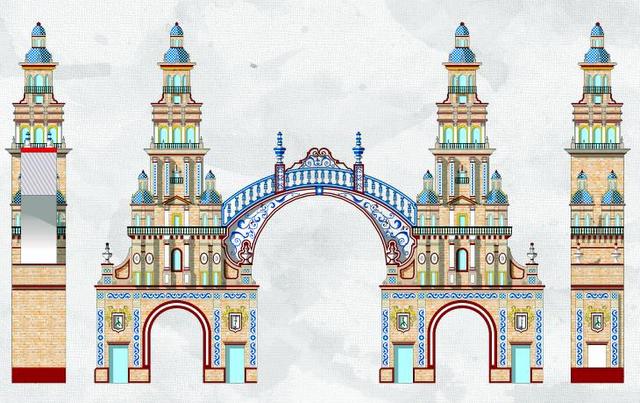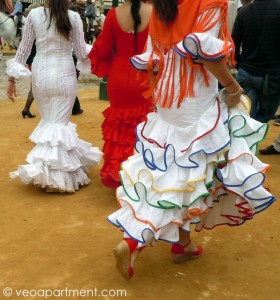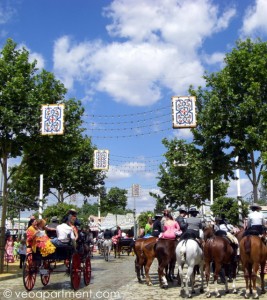
Feria Portada 2013 – a representaion of the Plaza de España
The April Fair (Feria de Abril) is the second of Seville’s spring festivals. Normally held two weeks after the first one, Semana Santa, the Feria changes the religious theme to a celebration of spring and having a good time. This year the official dates are from Tuesday, April 16 to Sunday, April 21, with the alumbrado, the switching on of the lights, at midnight on Monday.
Unlike Semana Santa, which is concentrated in the city centre, the April Fair is held on a purpose-built site on the southern edge of the suburb of Los Remedios, on land reclaimed from the old course of the river, so although it’s only about a 15 minute walk from the Puerta de Jerez, it doesn’t disrupt daily life in the same way, though some shops and bars may be closed at the weekend.
 The first April Fair was held in 1847 on the Prado (field) de San Sebastian, just outside the old city walls, which at that time were still standing, and it was initially a cattle and horse fair intended as a modern version of the old mediaeval fairs. Strangely for what has become such a Sevillano event, it was the brainchild of a Catalan, Narciso Bonaplata, and the Basque José María Ybarra. As the years passed the Fair gradually began to acquire the character it has today. The horses and carriages have remained a staple of the fair, at least during the day, as have the traditional traje corto (short jacket and tight trousers) of the men and colourful flamenco dresses of the women, but the cattle are long gone. The first electric lights appeared in 1874, followed shortly by the paper globes that are so typical today, and the first commercial casetas. In 1973 the Feria moved to its present home.
The first April Fair was held in 1847 on the Prado (field) de San Sebastian, just outside the old city walls, which at that time were still standing, and it was initially a cattle and horse fair intended as a modern version of the old mediaeval fairs. Strangely for what has become such a Sevillano event, it was the brainchild of a Catalan, Narciso Bonaplata, and the Basque José María Ybarra. As the years passed the Fair gradually began to acquire the character it has today. The horses and carriages have remained a staple of the fair, at least during the day, as have the traditional traje corto (short jacket and tight trousers) of the men and colourful flamenco dresses of the women, but the cattle are long gone. The first electric lights appeared in 1874, followed shortly by the paper globes that are so typical today, and the first commercial casetas. In 1973 the Feria moved to its present home.
The main entrance to the fair is through a gateway, the portada, which has a different theme each year. This year it’s a stylised representation of the Plaza España. Inside, the streets of the fairground are lined with casetas, small marquee style tents where food and drinks are sold. Although some of the casetas are public, the majority are owned by companies, associations, rich individuals and groups of friends.
 During the day it’s the horses and carriages that take the attention, along with their riders, everything and everyone done up to the nines to parade around the fairground, and for anyone with a love of horses this alone is enough to make Feria worth a visit. At night, however, Feria is quite a different experience. The lights are all switched on, and the party begins. In the casetas there is much drinking of rebujitos (sherry with 7-up) and dancing of Sevillanas (a folk dance with flamenco-style music), that often carries on until dawn. Next to the main fairground, in the Calle del Infierno (Hell Street) is a funfair, with all the traditional rides and typical fast-food stalls.
During the day it’s the horses and carriages that take the attention, along with their riders, everything and everyone done up to the nines to parade around the fairground, and for anyone with a love of horses this alone is enough to make Feria worth a visit. At night, however, Feria is quite a different experience. The lights are all switched on, and the party begins. In the casetas there is much drinking of rebujitos (sherry with 7-up) and dancing of Sevillanas (a folk dance with flamenco-style music), that often carries on until dawn. Next to the main fairground, in the Calle del Infierno (Hell Street) is a funfair, with all the traditional rides and typical fast-food stalls.
To get to the fairground you can take a taxi, one of the regular bus services 6 or C1/C2, or the special Feria bus service that runs from the Prado San Sebastian. It’s also possible to walk, especially if you’re in the southern part of the city.